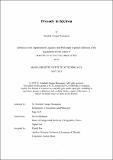Prosody in Kichwa
Author(s)
Chango Masaquiza, Soledad
DownloadThesis PDF (4.107Mb)
Advisor
Richards, Norvin
Terms of use
Metadata
Show full item recordAbstract
This thesis investigates the prosodic system of Salasaka Kichwa, focusing on the interaction between pitch, morphosyntactic structure, and word order in both elicited and spontaneous speech. Based on data from ten native speakers of the Salasaka community, the study analyzes approximately 150 utterances using Praat and ToBI-style prosodic annotation. The findings reveal a consistent alignment between the nuclear pitch accent and the leftmost constituent of the verb phrase in neutral declarative sentences, supporting the hypothesis that Salasaka Kichwa exhibits a head-final syntactic structure. This default prosodic alignment is disrupted by the presence of focus-sensitive or interrogative morphemes such as -mi and -chu, which reliably attract the pitch peak regardless of their position in the clause. In ditransitive constructions, pitch prominence consistently targets the dative-marked argument. Accusative-marked objects also receive prominence, but only when modified; in such cases, it is typically the modifying adjective or contrastive element that bears the highest pitch. Overall, the study demonstrates that prosodic prominence in Salasaka Kichwa is not governed by syntactic structure alone. Instead, it emerges from a layered interaction between morphology, information structure, and pragmatic marking offering new insights into how prosody encodes grammatical and communicative functions in underdescribed head-final languages.
Date issued
2025-05Department
Massachusetts Institute of Technology. Department of Linguistics and PhilosophyPublisher
Massachusetts Institute of Technology